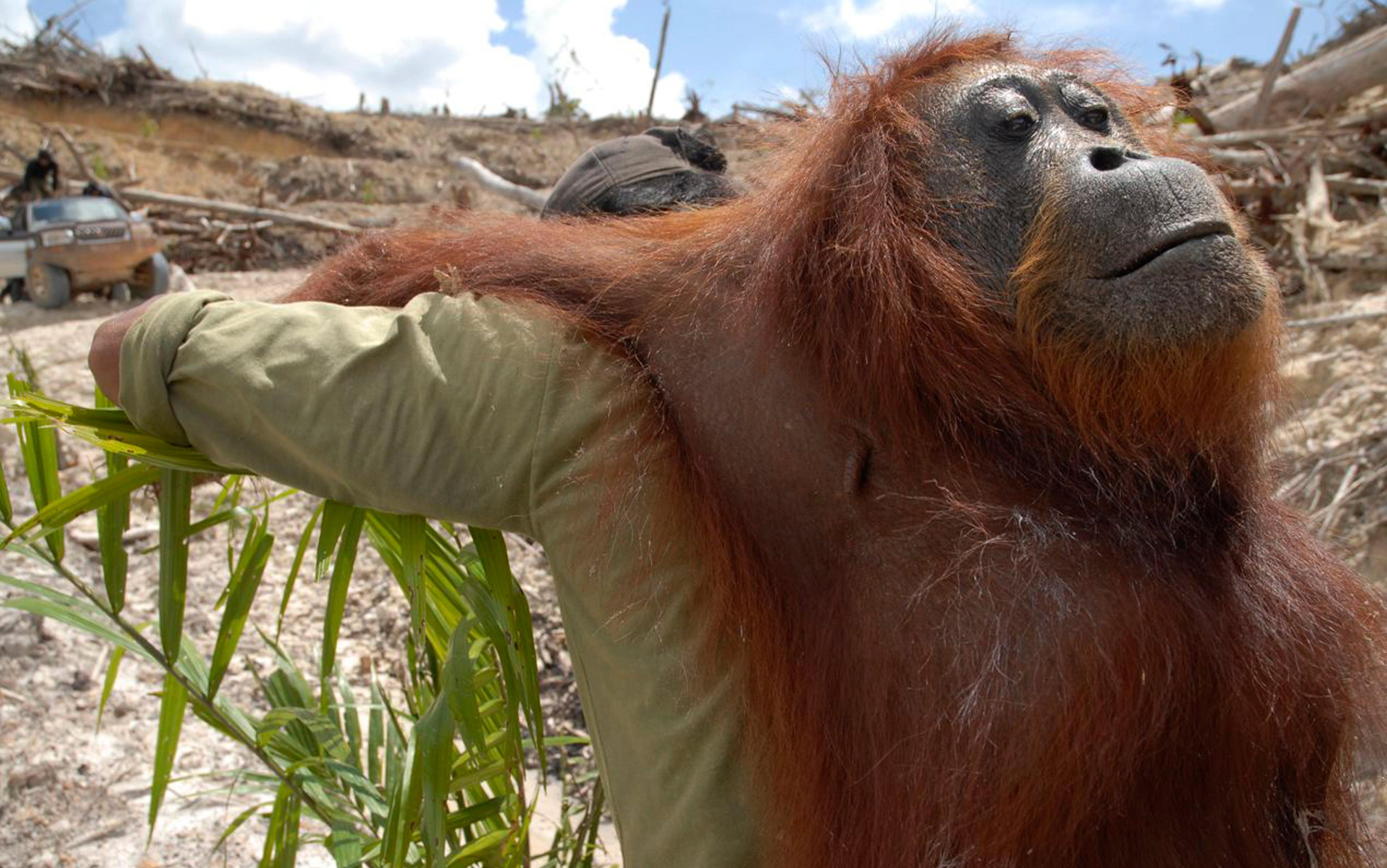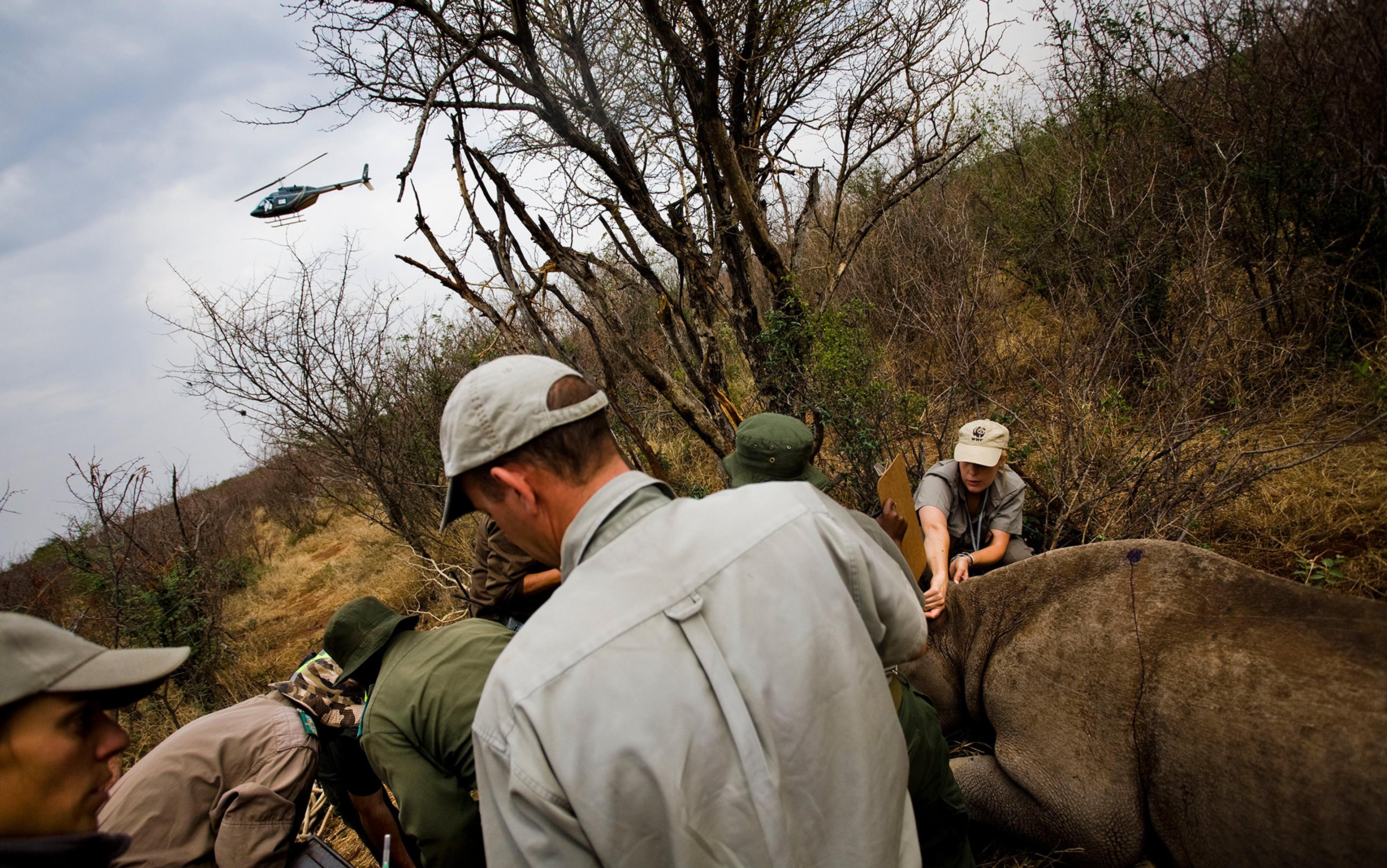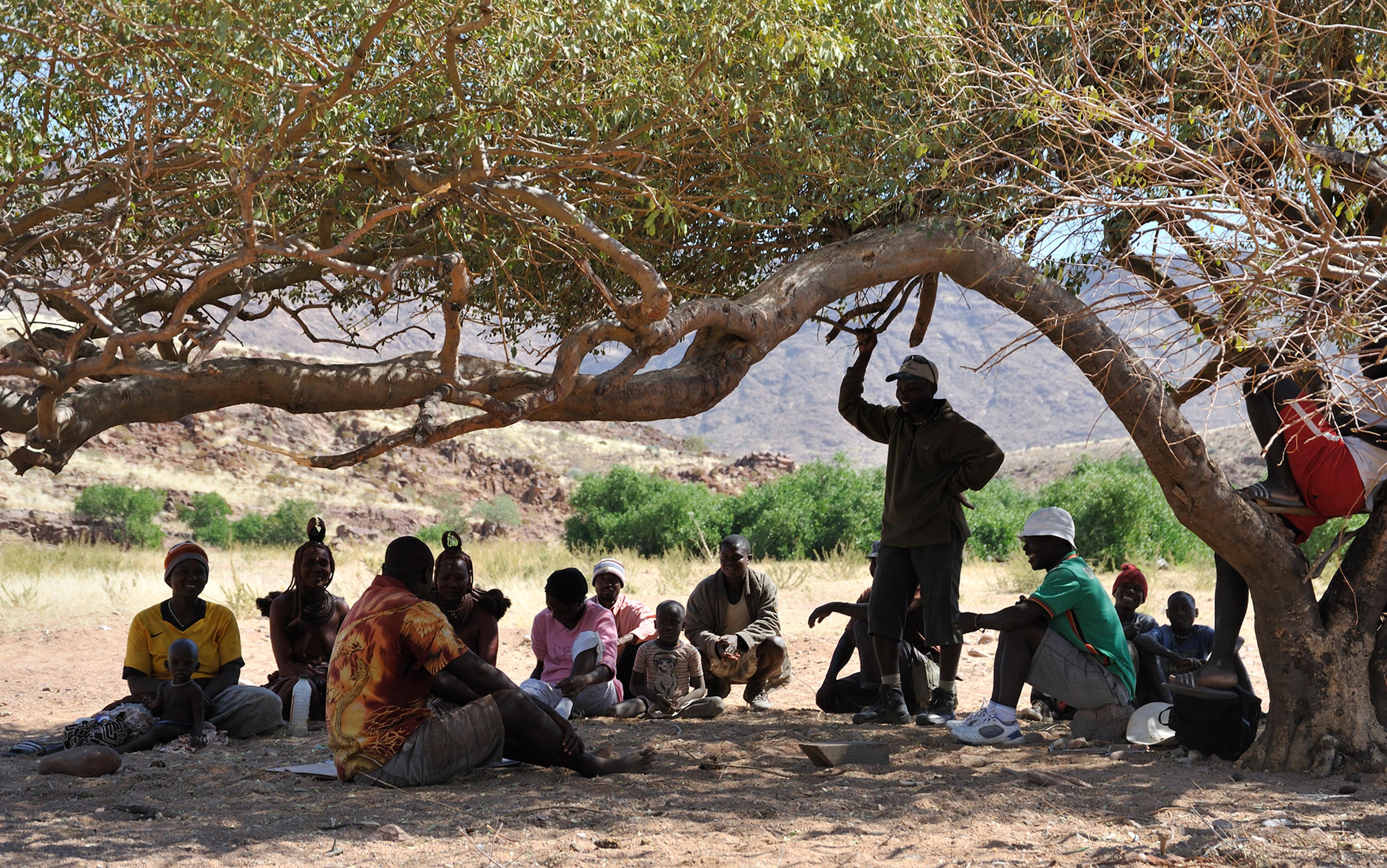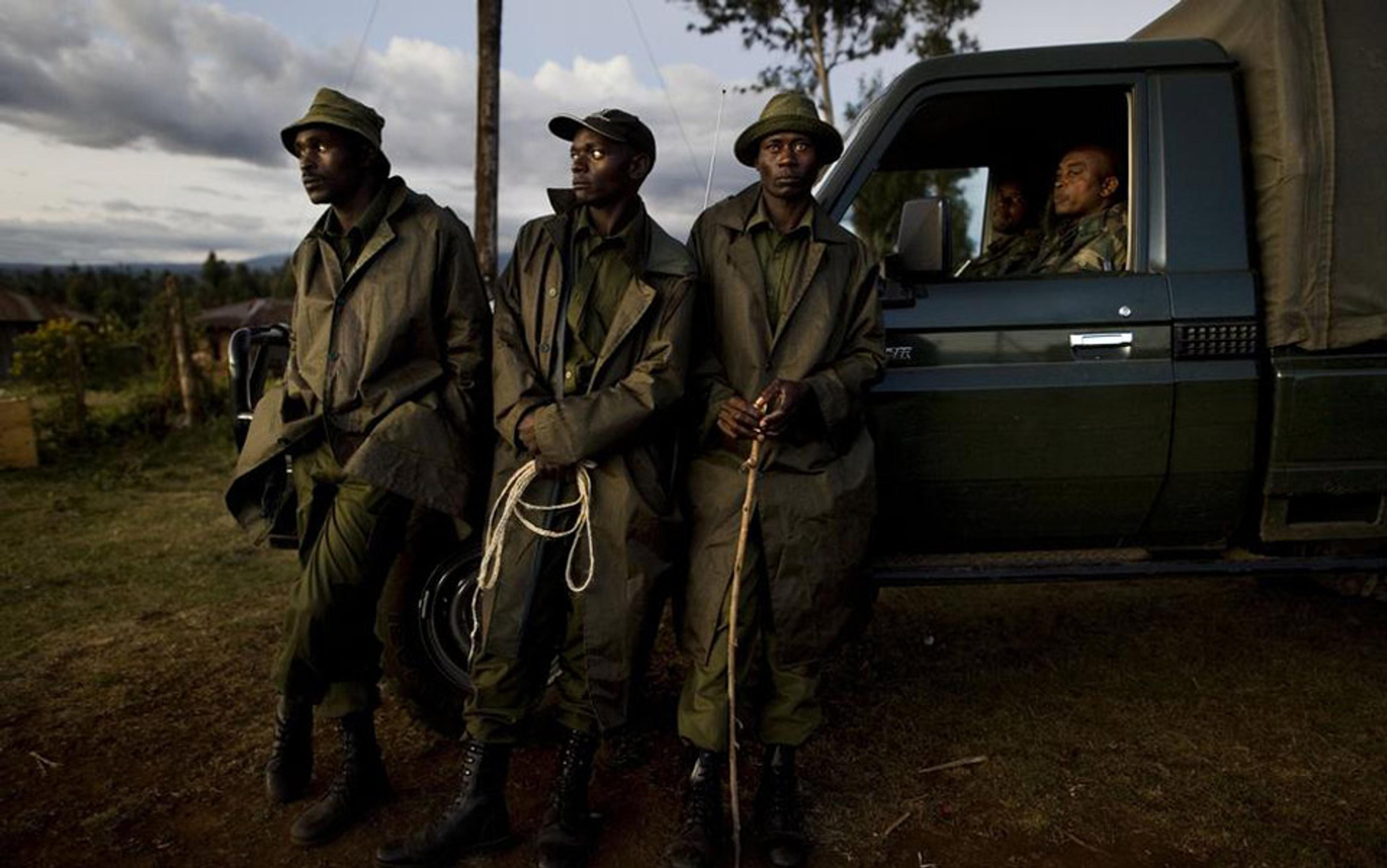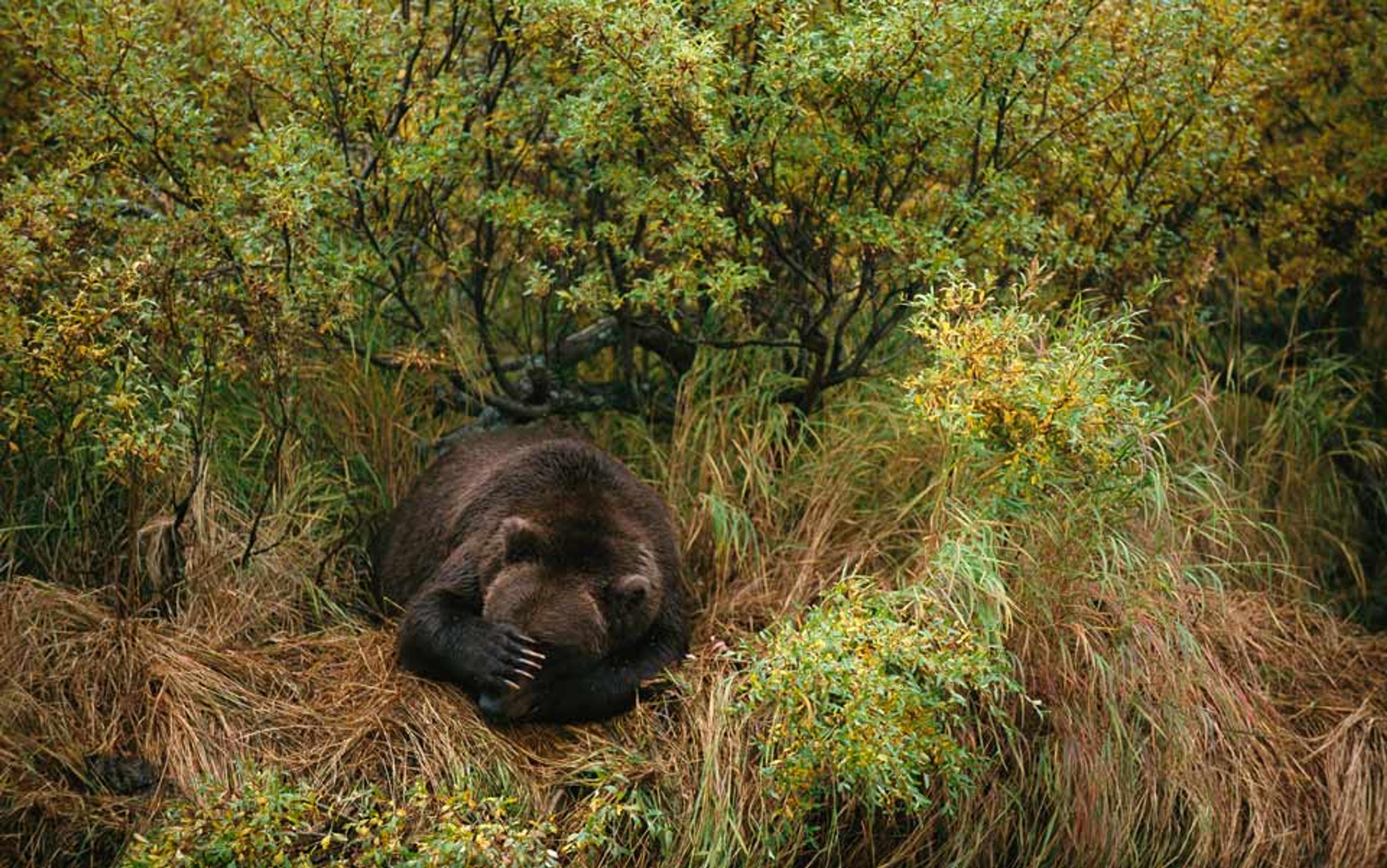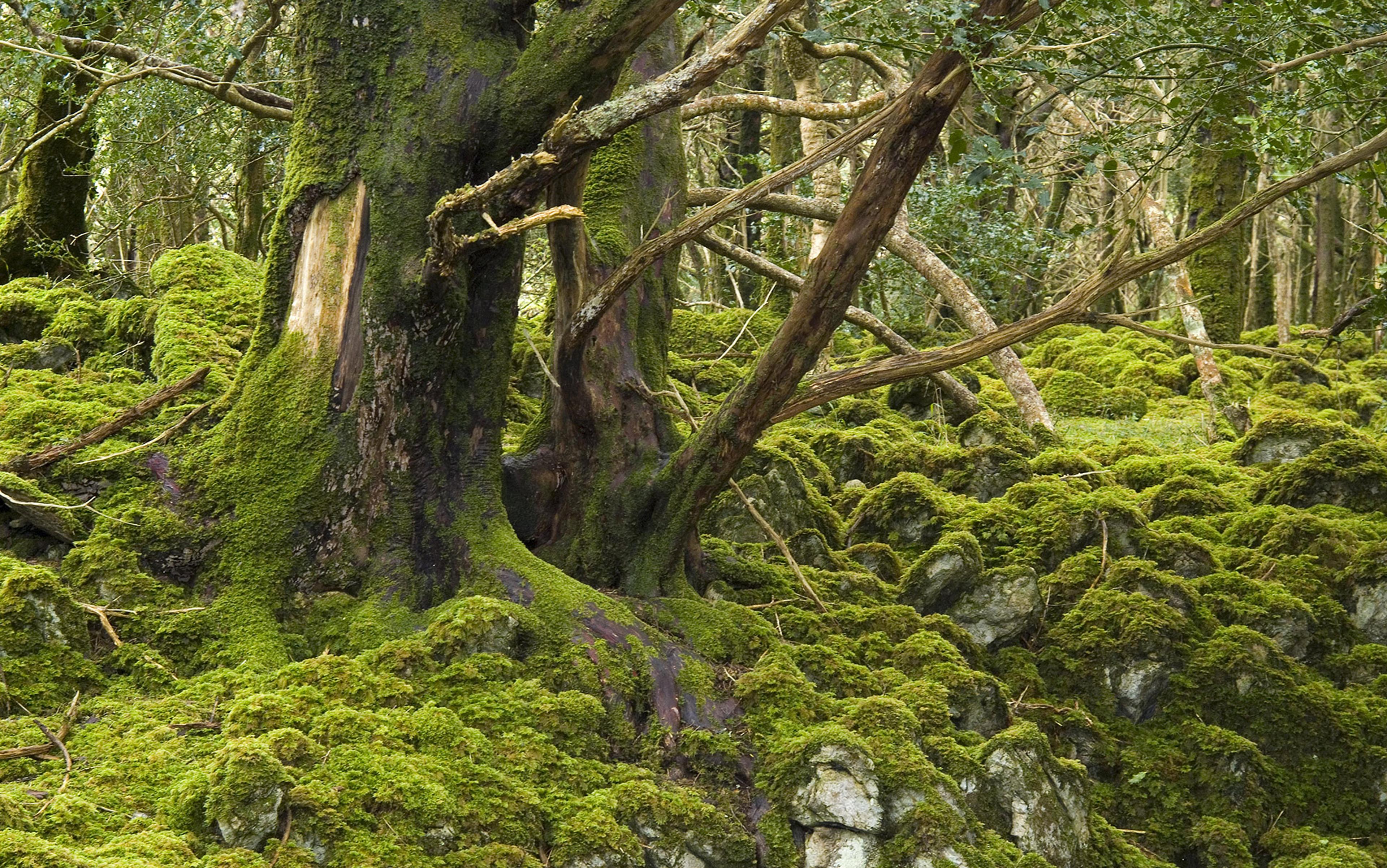When Ricko Jaya first laid eyes on the orangutan, it was crouched in a jackfruit tree and stinking of rot. Even from the ground below, Jaya, a veterinarian and the coordinator of the Human and Orangutan Conflict Response Unit (HOCRU) on the Indonesian island of Sumatra, could see the animal’s festering wounds. This was a large male with prominent cheek pads that indicate dominance. He’d been hanging around the orchard for at least a week, nursing his injuries, before one of Jaya’s field operatives caught wind and called headquarters.
Now rescue was here and the orangutan wasn’t going without a fight. He clung to a branch and glowered down at the humans below. Jaya shot him with a tranquiliser dart, and the orangutan – later nicknamed Raya – fell down onto an outstretched net. The injuries were bad, with gashes on shoulders and torso, abdominal bullet wounds, and a badly swollen face. Jaya and his colleague and wife, Yenny Jaya, loaded Raya into the back of their van, hooked him up to an intravenous drip and started the tedious 12-hour drive back to an orangutan rehabilitation compound on the outskirts of Medan, a swarming, sprawling port city on Sumatra.
There, in the centre’s specially designed clinic, they sedated Raya again and pulled out more than a dozen air-rifle bullets – which, to their horror, had been sharpened at the tip for maximum penetration. Raya had been beaten so badly that X-rays revealed a broken jaw and fractured skull. The Jayas had rescued dozens of orangutans that had ventured too close to village forests. Often, the animals had been shot, but Raya’s injuries were extreme, as if ‘he’d gone 10 rounds with Mike Tyson’, Jaya recalled.
An orangutan in a jackfruit tree is not an uncommon sight in rural Sumatra, one of only two islands in the world (the other being Borneo) where orangutans live in the wild. But the range of Sumatra’s 6,000 orangutans is large. A single female will cover 1,500 hectares of forest canopy in search of food, a male almost double that. As available forest shrinks, orangutans are increasingly forced into contact with villages and plantations or logging camps.
The agencies trying to protect orangutans have long dealt with poachers kidnapping the animals and selling them on the black market, where orangutans are valuable commodities for wildlife parks and zoos. But the bigger threat now comes from small farmers and others on the front lines of the food supply chain. Aggression from these citizen-stakeholders represents resistance against powerful human players encroaching on their territory, their livelihood and their rights, bringing chaos to their front door.
The struggle between the various players is nuanced and complex, and, for outsiders, often difficult to understand. To local farmers and other people long residing in disputed lands, the enemy isn’t actually a wild animal, nor is it an environmental policy meant to protect those animals – but rather the policy’s impact on their livelihoods and lives. Biologists can count animals and estimate how much habitat they need to survive. International conservation organisations can press governments to set aside protected areas for wildlife. But with resources scarce and finite, the same wild animals so sacred to Western conservation can turn into targets for those forced to share less and less land, people in the far-flung corners of an empire who hold little of its money or decision-making power.
In 2010, the environmental biologist Nils Peterson of North Carolina State University helped to explain the developing world’s so-called war between humans and animals in a seminal paper in Conservation Letters. ‘Human-wildlife conflict has emerged as the central vocabulary for cases requiring balance between resource demands of humans and wildlife,’ he wrote, but the ‘phrase is problematic because, given traditional definitions of conflict, it positions wildlife as conscious human antagonists.’ Thinking of the conflict as some kind of war between humans and animals is just wrong. Instead, humans and wildlife must co‑exist, and the conflict can be resolved only when the interests of all the species are the same. To ‘facilitate a more productive interpretation of human-wildlife relationships’ we must see the conflict for what it is – a dispute between humans over how the wildlife and other natural resources should be managed, an elemental struggle over the use of land.
The phenomenon is global. In 2009, a group of villagers from Engare Nairobi in the Hai district along the western slopes of Mount Kilimanjaro in Tanzania drove a herd of elephants off a cliff to their deaths. The elephants were protected by law and valuable for the tourism industry. Their ivory is worth a great deal on the black market. But the villagers didn’t take the animals’ tusks, only photos of themselves, posing on top of the carcasses, which came to the attention of several conservation field researchers working in the area at the time.
A year’s supply of maize could be lost in a single night to a single foraging elephant
Determined to understand the killings, the biologist Sayuni Mariki, who was born in Tanzania, and her team from the Norwegian University of Life Sciences set out to interview local farmers. What they found was disturbing. Nearly 30 per cent of the land in Tanzania is now protected in national parks and reserves, which bring in a fifth of the country’s gross domestic revenues through tourism. Kilimanjaro National Park, the highest-grossing national park in Tanzania, brings in $17 million in user fees and permits per year from thousands of international tourists who come to summit the mountain and watch wildlife.
But very little trickles down to households, where subsistence farming has kept many in poverty. There was none of what conservation theorists call ‘instrumental’ value; the elephants weren’t actually useful for these villagers in terms of their personal income. Plus, they were a major nuisance. Over the course of their interviews, the researchers learned that nearly 1,000 acres of crops had been raided by elephants in the past year. A year’s supply of maize could be lost in a single night to a single foraging elephant.
To prevent this kind of damage, farmers had tried to protect their land with spiky acacia fences and fend off the elephants with chili peppers and torches to varying degrees of success, but no one reported receiving compensation for their losses – compensation, by the way, that is supposed to be provided under Tanzania’s 2009 Wildlife Conservation Act. Instead, local citizens had to absorb the costs of living with elephants, while the profits from tourism went to others. The killings, a villager told the research team, were ‘a way to tell the government we are tormented’.
A similar dynamic appears to be at work in Indonesia, where orangutans hold on by a thread. In 2012, the conservation scientist Erik Meijaard, now at the University of Queensland, surveyed nearly 7,000 people in 687 villages on Borneo. The thing that shocked Meijaard most were the numbers of deaths: between 750 and 1,790 orangutans were killed in the survey area in 2011 alone. Expanded to include the orangutans’ total range, that would amount to between 1,970 and 3,100 killed annually. Meijaard’s field workers, people who grew up in these villages, could hardly believe the numbers; in their experience, maybe one orangutan was killed every year or two. But multiply one orangutan per year over hundreds of villages, and the numbers add up to the low end of Meijaard’s estimates, losses that the remaining orangutan population simply cannot sustain.
In Sumatra, the frustration directed at wildlife is even more heated, demanding that HOCRU conduct constant training and incursions. Jaya and his team teach local residents to build bamboo cannons, kerosene-powered firecrackers that make a loud noise to scatter orangutans rather than shoot them. As a last resort, they tranquilise a problem animal and move it somewhere else. ‘We want to act before a conflict gets a victim,’ explains Jaya, ‘because an orangutan in a plantation has already become a conflict.’
Whenever we see large, charismatic animals and conservation at the crosshairs of a fight in the developing world, the true conflict, the human-to-human conflict, is over two competing uses for land that squeeze populations of wild animals between them. In Kenya, arable land presses up against the national parks, corralling elephants inside their boundaries and causing severe conflicts in elephant migration corridors. In Tanzania, large areas are leased to wildlife hunting concessions centred in the Arab Gulf states; Maasai herders – whose lifeways are traditionally compatible with wildlife – are routinely excluded by armoured vehicles patrolling the boundaries of the secretive concessions.
And in Sumatra, small farmers, logging concessions and rubber plantations hoping to sustain their modest operations, have been pushed aside by rapacious palm-oil plantations, whose products sold for almost $18 billion dollars in 2012 alone. Most of that production occurs after land used for other activities is slashed and burned, stripping soil of nutrients and making rehabilitation difficult to impossible. And, unlike the rubber plantations that are now being overrun, palm is low, spiky and completely inhospitable to orangutans, which require a high canopy to cover long distances in search of just-ripening fruit trees. As palm plantations multiply and expand, orangutans either become marooned in narrow stands of trees or move on to more suitable habitat – usually mixed-use forests, part-palm and part-fruit or nut-farming combined with logging, managed by rural villagers whose operations are stymied by simian pests.
The village of Sei Serdang, about two hours northwest of Medan, is home to some 200 families, a third of them working for a nearby palm-oil plantation, many others labouring in the forest on tasks such as collecting fruit. Along with the HOCRU field coordinator Krisna Ketalep and his local contact Rudi, I looped around the forest, speaking to a dozen or so farmers working the land. Yes, they said, orangutans come in and eat fruit sometimes. (One study, led by Gail Campbell-Smith of the Durrell Institute of Conservation and Ecology in the UK, and published in 2011, counted 1,204 independent crop-raiding incidents by orangutans over a period of nearly two years here.)
Yet of all the people I spoke with, just one man admitted to thoughts of shooting the protected apes; he lost a small fortune in fruit last year, he said, and just might shoot an orangutan if he had a rifle. Another farmer with a gun hanging from the handle of his motorbike pointed to an abandoned nest in a tree on his property. Just yesterday, an orangutan had been here picking and eating beans that the farmer could have taken to market and sold. No, he wouldn’t shoot it. ‘Maybe people in other areas do that,’ he said.
‘That’s what everyone says,’ Ketalep whispered to me as we walked away. ‘But the truth is, every orangutan that comes out of here has been shot.’
few understand that, when they speak up for animals, vulnerable human rights might also hinge on their words
All the interspecies strife emerges from what the biologist E O Wilson called the ‘awful symmetry’ of biodiversity. The wealthiest people in the world live among a paucity of biological wealth while the poorest are living alongside some of the most magnificent examples of biodiversity, especially those charismatic megafauna – the orangutans and lions and elephants – that capture Western media attention, public imagination and charitable dollars.
Outside Indonesia, orangutans draw wealthy patrons happy to donate and promote the cause, says Dan Brockington, professor of conservation and development at the University of Manchester. For the celebrities, there’s no cost and only public-relations benefit, including a warm and fuzzy public image from all the photo ops. Yet those belonging to the conservation media circus usually know little about the complex trade-offs between livelihoods and wildlife that go on everywhere in the world – and few understand that, when they speak up for animals, vulnerable human rights might also hinge on their words.
Viewing conservation through this charismatic lens shows how capitalism and development can become intertwined. Big donors might be far more interested in hobnobbing with the British actors Russell Brand and Ricky Gervais or the Spanish singer Enrique Iglesias (three of the guests of the Jungle VIP Auction on behalf of the Sumatran Orangutan Society in 2013) than actually coming to understand the issues underlying the conflicts at hand. Yet celebrities and foreign donors do bring in money – funds that, if used correctly, could help all the species at risk.
The Sumatran Orangutan Conservation Programme (SOCP), which runs the rehabilitation centre where Raya spent his last days, is funded primarily by foreign dollars. The money maintains a clinic, full-time staff, spacious outdoor enclosures for the adult orangutans (there are usually around 70 orangutans at any given time), and a nursery and 24-hour staff for the orphaned babies. The babies, especially, have drawn a group of eco-tourists to the centre on the day I visit. One of them, a Canadian, has spent her past three vacations doing orangutan tourism in Indonesia. The Australian tour company Orangutan Odysseys is helped by the publicity, and is the only company that Ian Singleton, the British-born SOCP director, will work with.
Singleton remains cautious about tourism. An early rehabilitation-and-release site in Bukit Lawang, south of Medan, is now a kind of cageless zoo where orangutans live in the forest but are enticed closer to visitors with food, and it’s become a ‘red alert’ for conservationists who wish to keep orangutans truly wild. But, tourism is one way to pay the bills. The SOCP is essentially doing the work necessary to enforce government laws to protect orangutans, but receives no government funding for it.
The orangutans’ high profile has paid off in other ways. In 2007, the SOCP and other non-profits helped to publicise lawsuits against palm companies operating illegally in the Tripa forest, a boggy peatland ecosystem with enormous importance both as orangutan habitat and as a carbon sink. Branding it ‘the orangutan capital of the world’, they created a successful campaign that drew major media coverage while an online petition attracted 1.5 million signatures.
Incredibly, the Indonesian judicial system actually responded; last year, the case went to court and, in a precedent-setting decision, an Indonesian judge found the palm-oil company PT Kallista Alam guilty of illegally clearing and burning forest to plant palms, and ordered it to pay $30 million in fines and reparations. The case flung palm oil and its impact on orangutans and orangutan habitat into the public sphere. Since then, the centre has hosted two film crews a month, from Japan to Britain, says Singleton. ‘And it’s bloody exhausting.’
It’s no wonder that Singleton is cynical about the orangutan’s protected status in Indonesia, a place, he says, where ‘corrupt officials pay lip service to their protection while turning a blind eye towards trafficking’. Singleton is aware that he is one in a ‘long line of white people coming in to tell Indonesians how to do conservation’, but says that’s beginning to change. In the past decade, a new generation of Indonesian environmental activists have begun to make headway on the major resource and land issues in the country by putting wildlife aside and focusing instead on the people on the ground; the humans whose land and livelihoods are also threatened by palm-oil companies.
Armed with smartphones, GPS and chainsaws, they have cut back hectares of palm illegally planted in protected areas
Recently, Harry Surjadi, an Indonesian environmental journalist, began recruiting and training farmers in remote corners of Sumatra’s Riau province to act as citizen journalists, sending text-message reports on palm-plantation activities to subscribers from mainstream media, government and activist organisations. It’s an expansion of a programme Surjadi launched in Borneo, where it’s been successful in helping to resolve disputes between local communities and powerful palm companies.
Last year, Rudi Putra, a Sumatran biologist, won the prestigious international Goldman Environmental Prize for his work monitoring palm-oil companies. The non-profit he runs, the HAkA Foundation in Banda Aceh on Sumatra, is staffed by young, passionate local citizens who are coalescing their efforts around protecting the Leuser ecosystem, a 2.6-million hectare swath of tropical old-growth rainforest. Armed with smartphones, GPS and chainsaws, his teams have worked with local police forces and municipal governments to cut back hectares of palm that has been illegally planted in protected areas within Leuser and community forests around it. Leuser is ecologically unique – the only place where tigers, elephants, rhinos and orangutans exist together – but that’s not the message that Putra and his team focus on. Rather, they frame the issue around water: the more intact forest, the more water the region will sustain. The less logging, the fewer and less severe the floods.
People get it, says Putra. When the interests of wildlife and local people are in sync – in protecting watersheds or forests, for example – then conservation becomes possible. Having an ‘animals versus humans’ approach helps no species prevail. The alignment of interests comes when you recognise that the so-called human-wildlife conflict is a convenient obfuscation for the powerful, and that its true root lies in the pressure placed on traditional small farming and other livelihoods when greedy players usurp lands both from humans and from wild species.
In a guest blog for the Rainforest Action Network last year, Putra wrote:
It must stop. We must protect the world’s rainforests. We must stop powerful and wealthy international corporations from exploiting and destroying irreplaceable Indonesian ecosystems for profit. My community and I work tirelessly to shut down and destroy illegal palm-oil plantations …We do this to protect our families from the floods that result from the destruction of the forests on the hillsides that surround our homes.
So should Indonesians be convinced to feel a sense of urgency around saving orangutans? Maybe that isn’t the point. If Indonesians protect their land, water and rainforests, they will de facto be protecting the orangutans. Protect these things, says Putra, ‘and wildlife is a bonus’.
